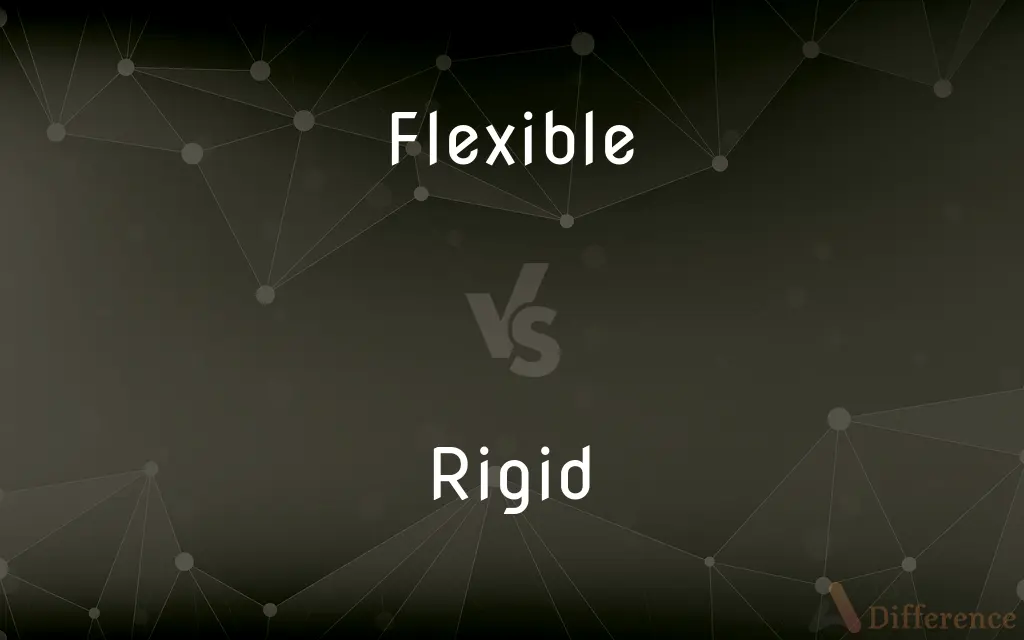Flexible vs. Rigid — What's the Difference?
By Maham Liaqat & Fiza Rafique — Updated on April 25, 2024
Flexible items adapt to changes and can bend without breaking, while rigid items maintain a fixed form and resist deformation.

Difference Between Flexible and Rigid
Table of Contents
ADVERTISEMENT
Key Differences
Flexible materials or objects are designed to be adaptable, easily bending or twisting without breaking, which makes them ideal for applications where movement or elasticity is required. On the other hand, rigid materials or objects cannot bend or twist easily and are better suited for structures needing high stability.
In terms of decision-making, a flexible approach allows for adjustments based on changing conditions, promoting innovation and responsive strategies. Whereas, a rigid approach follows strict rules or plans, providing consistency and predictability but often at the cost of adaptability.
Flexibility in scheduling means having the ability to adjust work hours or tasks according to personal needs or unforeseen circumstances, enhancing employee satisfaction and productivity. Conversely, rigid scheduling enforces fixed hours and tasks, which can streamline operations but might reduce morale if it doesn't consider individual circumstances.
In software development, flexible systems are designed to accommodate changes in technology or user requirements, often using modular or scalable architectures. On the other hand, rigid systems adhere to a set architecture and are difficult to modify, potentially leading to higher costs or obsolescence if the initial specifications no longer align with user needs.
From a psychological perspective, people who are flexible in their thinking can adapt their beliefs and responses based on new information, which is crucial for learning and growth. In contrast, rigid thinking locks individuals into specific patterns or beliefs, which can limit their understanding and interactions in a changing environment.
ADVERTISEMENT
Comparison Chart
Physical properties
Can bend or twist without breaking
Cannot bend or twist; maintains form
Applications
Suitable for dynamic environments
Suited for static, stable conditions
Decision-making
Adapts to changing conditions
Follows strict rules or plans
Software architecture
Modular and scalable
Set and difficult to modify
Psychological impact
Promotes growth and learning
Limits adaptability and understanding
Compare with Definitions
Flexible
Capable of bending easily without breaking.
The flexible rubber hose can be stored in compact coils.
Rigid
Unable to bend or be forced out of shape; not flexible.
The rigid metal beam supports the weight of the building.
Flexible
Ready and able to change so as to adapt to different circumstances.
You need to be flexible to succeed in a fast-changing environment.
Rigid
(Of rules, systems, etc.) strictly applied or enforced.
The military operates under rigid discipline.
Flexible
(Of materials) able to be easily modified to respond to altered circumstances.
Flexible working hours have become more common.
Rigid
Unwilling or unable to change one’s ideas or behaviors.
His rigid mindset made it difficult to discuss new ideas.
Flexible
Not strictly enforced; open to modification.
The guidelines are flexible and can be adapted as necessary.
Rigid
Very strict and difficult to change.
The schedule is rigid and allows for no deviations.
Flexible
Willing to change or compromise.
The manager was flexible and allowed her to work from home.
Rigid
Not able to be changed or adapted.
The company has a rigid policy against working from home.
Flexible
Capable of bending easily without breaking
Flexible rubber seals
Rigid
Unable to bend or be forced out of shape; not flexible
A seat of rigid orange plastic
Flexible
Capable of being bent or flexed; pliable
A flexible hose.
Rigid
Not able to be changed or adapted
Rigid bureaucratic controls
Flexible
Readily bending or twisting the body without injury
You can play soccer much better if you're flexible.
Rigid
A lorry which is not articulated.
Flexible
Able to change to cope with variable circumstances
"a flexible and quietly competent administrator" (Jerome Karabel).
Rigid
Not flexible or pliant; stiff
A rigid material.
Flexible
Capable of being changed or adjusted to meet particular or varied needs
A job with flexible hours.
A flexible definition of normality.
Rigid
Not moving or flexing
Rigid muscles.
Flexible
Capable of being flexed or bent without breaking; able to be turned or twisted without breaking.
Rigid
Not changing or adjusting to different conditions or problems
A rigid thinker.
A rigid hierarchy.
Flexible
Willing or prone to give way to the influence of others; not invincibly rigid or obstinate.
Rigid
Scrupulously or severely maintained or performed; rigorous or harsh
Rigid discipline.
Flexible
Capable or being adapted or molded in some way.
A flexible language
Rigid
Being an airship with a external frame made of rigid parts.
Flexible
Something that is flexible.
Rigid
Stiff, rather than flexible.
Flexible
Capable of being flexed or bent; admitting of being turned, bowed, or twisted, without breaking; pliable; yielding to pressure; not stiff or brittle.
When the splitting windMakes flexible the knees of knotted oaks.
Rigid
Fixed, rather than moving.
Flexible
Willing or ready to yield to the influence of others; not invincibly rigid or obstinate; tractable; manageable; ductile; easy and compliant; wavering.
Phocion was a man of great severity, and no ways flexible to the will of the people.
Women are soft, mild, pitiful, and flexible.
Rigid
Rigorous and unbending.
Flexible
Capable or being adapted or molded; plastic,; as, a flexible language.
This was a principle more flexible to their purpose.
Rigid
Uncompromising.
Flexible
Extended meanings; capable of change;
A flexible character
Flexible schedules
Rigid
(aviation) An airship whose shape is maintained solely by an internal and/or external rigid structural framework, without using internal gas pressure to stiffen the vehicle (the lifting gas is at atmospheric pressure); typically also equipped with multiple redundant gasbags, unlike other types of airship.
The rigid could reach the greatest sizes and speeds of any airship, but was expensive to build and bulky to store. Rigids fell out of favor after the R101 and Hindenburg disasters made the type seem unsafe to the travelling public.
Flexible
Able to flex; able to bend easily;
Slim flexible birches
Rigid
A bicycle with no suspension system.
Flexible
Able to adjust readily to different conditions;
An adaptable person
A flexible personality
An elastic clause in a contract
Rigid
Firm; stiff; unyielding; not pliant; not flexible.
Upright beams innumerableOf rigid spears.
Flexible
Bending and snapping back readily without breaking
Rigid
Hence, not lax or indulgent; severe; inflexible; strict; as, a rigid father or master; rigid discipline; rigid criticism; a rigid sentence.
The more rigid order of principles in religion and government.
Flexible
Making or willing to make concessions;
Loneliness tore through him...whenever he thought of...even the compromising Louis du Tillet
Rigid
Incapable of or resistant to bending;
A rigid strip of metal
A table made of rigid plastic
A palace guardsman stiff as a poker
Rigid
Incapable of compromise or flexibility
Rigid
Incapable of adapting or changing to meet circumstances;
A rigid disciplinarian
An inflexible law
An unbending will to dominate
Rigid
Fixed and unmoving;
With eyes set in a fixed glassy stare
His bearded face already has a set hollow look
A face rigid with pain
Rigid
Designating an airship or dirigible having a form maintained by a stiff unyielding frame or structure
Common Curiosities
How does a rigid system affect software development?
Rigid systems make it challenging to incorporate changes or updates, potentially leading to higher costs and outdated software if not initially well-designed.
What does it mean when a material is described as flexible?
A flexible material can easily bend or stretch without breaking, allowing it to be used in various applications where flexibility is beneficial.
Can a person's thinking be both flexible and rigid?
While a person may predominantly exhibit one style, they can display both flexible and rigid thinking in different contexts or aspects of life.
Is it better to have a flexible or rigid approach in management?
The better approach depends on the specific circumstances and goals; flexibility can foster innovation, while rigidity can ensure stability and uniformity.
What are some examples of flexible materials?
Examples include rubber, certain plastics, and fabrics like spandex.
Can societal norms be flexible or rigid?
Societal norms can be both; they evolve over time but can also be strictly upheld depending on cultural values and historical context.
What are the advantages of flexible work policies?
Flexible work policies can improve work-life balance, increase job satisfaction, and potentially boost productivity by accommodating individual needs.
Why might an organization choose to maintain rigid structures?
Organizations might opt for rigid structures to ensure consistency, predictability, and control, particularly in environments where these qualities are crucial for success.
How do flexible and rigid materials differ in physical response?
Flexible materials respond to stress by bending or stretching, whereas rigid materials resist such changes and may break under enough stress.
What are some common uses of rigid materials?
Common uses include building supports, machinery parts, and protective casings.
What impact does rigid thinking have on personal relationships?
Rigid thinking can lead to conflicts and difficulties in personal relationships as it limits understanding and adaptability.
How does flexibility in policy-making affect governance?
Flexibility in policy-making allows governments to adapt regulations to emerging challenges and needs, making governance more responsive and effective.
How can flexibility be a disadvantage?
Excessive flexibility might lead to a lack of structure or consistency, potentially causing confusion or inefficiency.
In what scenarios is rigidity considered beneficial?
Rigidity is beneficial in scenarios requiring high precision and control, such as in manufacturing processes or legal compliance.
What role does rigidity play in maintaining safety?
Rigidity in protocols and procedures is crucial in maintaining safety in various environments, ensuring that standards are met consistently.
Share Your Discovery

Previous Comparison
Brinjal vs. Eggplant
Next Comparison
Artisan vs. ArtistAuthor Spotlight
Written by
Maham LiaqatCo-written by
Fiza RafiqueFiza Rafique is a skilled content writer at AskDifference.com, where she meticulously refines and enhances written pieces. Drawing from her vast editorial expertise, Fiza ensures clarity, accuracy, and precision in every article. Passionate about language, she continually seeks to elevate the quality of content for readers worldwide.
















































